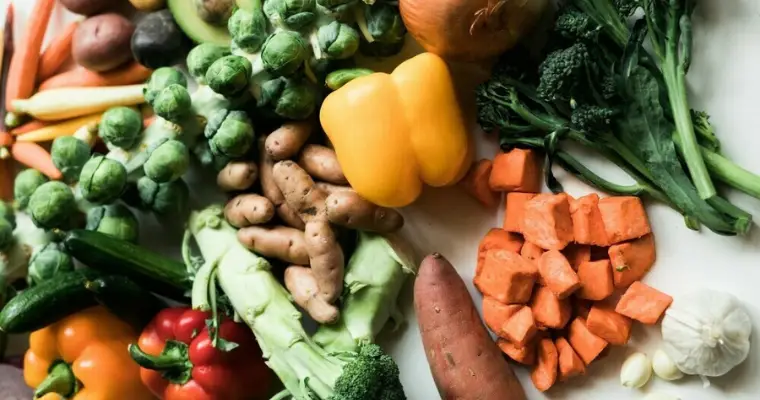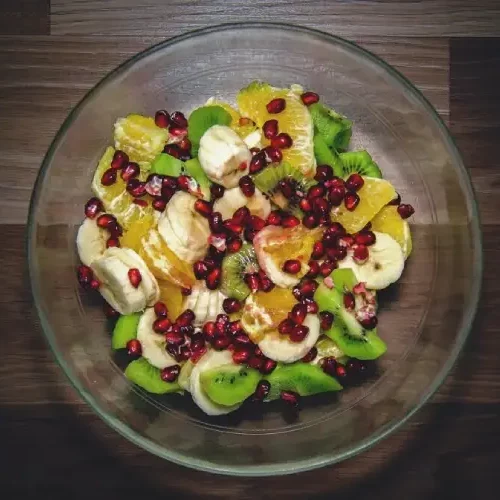Benefits of Winter Salads

As the frost sets in and the days grow shorter many people seek warmth in heartier cooked meals.
However, often overlooked are the nourishing potential benefits of winter salads during the colder months.
These vibrant dishes are more than just summer fare – they’re a treasure trove of seasonal goodness that can fortify our bodies and elevate our well-being during colder times.
Let’s investigate the distinct advantages of incorporating winter salads into your daily routine.
Embrace Winter Plant Based Goodness
Benefits of Winter Salads:
Winter salads, despite the chill, offer an array of benefits that complement the season.
Packed with nutrient-rich ingredients like dark leafy greens, root vegetables, and seasonal fruits, they provide a burst of vitamins, antioxidants, and fiber.
These salads support immune function, combat seasonal illnesses, and contribute to overall vitality.
Moreover, they offer a refreshing contrast to heavier winter meals, aiding in digestion and weight management.
Supports Seasonal Well-being:
The shorter days and colder temperatures often affect our mood and energy levels. Incorporating vibrant, nutrient-dense winter salads can combat seasonal blues.
The variety of colors, textures, and flavors in these salads stimulate the senses and uplift the spirit, promoting a sense of well-being.
Immune Boosting Power:
Winter salads are a reservoir of immune-boosting nutrients.
Dark leafy greens like kale and spinach are packed with vitamins A, C, and K, crucial for strengthening immunity and fighting off seasonal bugs.
Additionally, citrus fruits like oranges and lemons provide a punch of vitamin C, aiding in warding off colds and flu.
Nutrient Density:
Winter salads are a powerhouse of essential nutrients such as vitamins A, C, and K, as well as minerals like iron and potassium.
Leafy greens, citrus fruits, and cruciferous vegetables featured in these salads boost immunity and combat winter lethargy.
Weight Management and Satiety:
With holiday feasting and comfort foods prevalent during winter, maintaining a healthy weight becomes challenging.
Winter salads, abundant in fiber from vegetables, fruits, and grains, promote satiety without excess calories.
They keep you feeling full and satisfied, curbing unhealthy cravings and aiding in weight management.
Seasonal Versatility:
The winter season introduces an array of seasonal produce. Incorporating root vegetables like beets, carrots, and sweet potatoes.
Not forgetting the hearty grains, beans and legumes that enriches salads with diverse textures, flavors, and nutrients.
Availability of Ingredients in Winter:
The availability of specific ingredients for the winter salad recipes can vary depending on the season and region within the United States.
Here’s a breakdown:
Quinoa:
Quinoa is typically available year-round in most grocery stores in the US as it’s a widely popular and versatile grain.
Assorted Winter Vegetables (Beets, Carrots, Brussels Sprouts):
Root vegetables like beets and carrots are often available year-round, sourced from different regions or stored from previous harvests.
Brussels sprouts might have a more seasonal availability, generally from fall through winter.
Mixed Greens:
Various types of salad greens like spinach, arugula, and lettuce are usually available year-round in the US.
Oranges and Citrus Fruits:
Oranges are predominantly available throughout the year in the US, with variations in specific varieties depending on the season.
Other citrus fruits like lemons might have a more seasonal presence but are generally available in abundance during winter.
Apples, Pears, and Pomegranate Seeds:
While apples and pears might have their peak seasons in the fall, they are often stored and available year-round.
Pomegranate seeds might be more prevalent during the fall and winter months.
Pumpkin Seeds Walnuts or Pecans:
Seeds and nuts are generally available throughout the year in the US.
While some ingredients may have more prominent seasonal availability or vary slightly in quality depending on the time of year.
Many of these ingredients can typically be found year-round in the US due to modern farming, importing, and storage techniques.
However, their freshness and local availability might fluctuate based on specific regions and the time of the year.
Warm Quinoa and Roasted Vegetable Salad
Warm Quinoa and Roasted Vegetable Salad
Ingredients:
- 1 cup quinoa, cooked
- Assorted winter vegetables (e.g., beets, carrots, Brussels sprouts), chopped
- Mixed greens
- Tamari, balsamic vinegar, and cayenne pepper for dressing
- Fresh lemon
Instructions:
Roasting the Vegetables:
- Preheat your oven to 400°F (200°C).
- In a baking tray, spread out the chopped winter vegetables (you can choose a mix of root vegetables like beets, carrots, and Brussels sprouts) evenly.
- Drizzle with tamari and pepper, tossing to coat the vegetables thoroughly.
- Roast in the oven for about 20-25 minutes or until the vegetables are tender and slightly caramelized.
Assembling the Salad:
- In a large bowl, combine the cooked quinoa, roasted vegetables, and a handful of mixed greens.
- Drizzle with a blend of tamari and balsamic vinegar, gently tossing to coat all ingredients evenly.
- Season with fresh lemon and pepper according to your taste preferences.
Winter Salad Insight:
The roasted vegetables in this salad offer a delightful contrast in textures and flavors.
The roasting process intensifies their natural sweetness, making them a perfect complement to the nutty quinoa and fresh greens.
The combination provides a satisfying and wholesome meal that’s rich in both taste and nutrients.

Winter Fruit Salad with Citrus Mint Dressing
Equipment
- 1 Sharp Knife
- 1 Large Mixing Bowl
- 1 Small Mixing Bowl
- 1 Whisk
- 1 Zesting Tool
Ingredients
Salad Ingredients
- 2 Organic Apples Diced mix of sweet and tart varieties
- 2 Pears Diced
- 2 Small Kiwis Sliced thin
- 1 Cup Apple Bananas Sliced thin
- 1 Cup Fresh Cranberries
- 2 Oranges Peeled and segmented
- 1/2 Cup Pomegranate seeds
- 1/2 Cup Chopped Nuts or Seeds Pumpkin, walnuts or pecans
Citrus Mint Dressing Ingredients
- Juice of 2 small oranges
- Juice of one lemon or lime
- Zest from 1 Orange and 2 lemon
- 2 Tbsps. Date or Maple Syrup
- 1 Tbsp Fresh Mint or Thai Basil Chopped fine.
- Pinch of both ground Cinnamon and nutmeg for added warmth
Instructions
Salad Steps by Step Instructions:
- Prepare the Fruit: Wash and dice the apples and pears into bite-sized pieces.Cut the kiwis and bananas and segment the oranges. If using cranberries, rinse them thoroughly.
- Combine the Fruit: In a large mixing bowl, combine the diced apples, pears, kiwi, banana, oranges, pomegranate seeds, and cranberries Gently toss to mix.
- Make the Citrus Mint Dressing: In a separate bowl, whisk together the orange juice, lemon juice, orange and lemon zest, date or maple syrup, chopped mint leaves, and cinnamon or nutmeg.
- Assemble the Salad: Pour the citrus mint dressing over the mixed fruits.Gently toss the fruit salad to ensure the dressing coats all the fruits evenly.
- Chill and Then Serve: Allow the fruit salad to chill in the refrigerator for at least 30 minutes to let the flavors meld together.Before serving, sprinkle the chopped nuts and seeds over the salad for added crunch and texture.
Notes
Calories and Serving Size:
Serving size of this Winter Fruit Salad with Citrus Mint Dressing could be around 1 to 1.5 cups providing approximately 700-900 calories per serving. Adjusting the quantities of fruits or omitting nuts based on individual preferences can alter the calorie content. Remember, these calorie estimates are approximate and can vary based on fruit sizes, specific ingredients used, and individual portion sizes. If precise calorie information is necessary for dietary reasons, using a food scale and specific nutritional information for each ingredient can provide a more accurate count.Salad Insight:
This vibrant winter fruit salad is a delightful blend of seasonal fruits, offering a medley of flavors and textures. The combination of sweet bananas, kiwi, apples and pears, juicy oranges, tartness from the cranberries, and bursts of pomegranate seeds creates a refreshing palate. The citrus mint dressing elevates the salad, infusing it with a zesty and aromatic freshness, while the nuts and seeds provide a satisfying crunch. Enjoy the crispness and natural sweetness of this WFPB winter fruit salad, perfect for brightening up your table during the colder months while providing a nutritious and delectable treat! Enjoy the Winter Inside!Benefits of Winter Salads Closing Remarks
Winter salads, with their vibrant array of seasonal ingredients, embody a celebration of health and flavor, enriching our tables with nourishment and vitality during the colder months.
As we explored the benefits of these culinary delights, it becomes evident that they offer more than just a medley of tastes and textures.
From immune-boosting powerhouses like dark leafy greens and citrus fruits to the healthy nuts and seeds, each ingredient in these salads contributes to our well-being in its own unique way.
The advantages span beyond nutrition, touching on hydration, mental clarity, and even mood elevation, aligning perfectly with the holistic approach to health.
Exploring the recipes crafted with care and seasonal bounty, it’s clear that while some ingredients might have varied availability the essence of these dishes remains accessible year-round.
The versatility and adaptability of these recipes enable us to enjoy the benefits of winter salads regardless of the shifting seasons encouraging your creativity and exploration in the kitchen.
Conclusion
In closing, as winter graces us with its presence, let’s embrace the vibrancy and nourishment winter salads offer.
Let them be more than just a dish on our tables; let them be a cornerstone of your wellness journey.
Explore, create, and savor the goodness of these seasonal delights, fostering a healthier, more vibrant life one salad at a time.
Cheers to embracing the vitality of winter salads, sowing the seeds of wellness, and relishing the joy of a nourished, healthier you, no matter the season!
Please leave us a comment if you are looking for support on your wellness journey or have any questions about the benefits of winter salads.
BE SURE TO SIGN UP FOR YOUR > FREE 12 TIPS FOOD GUIDE <
Cheers,
Plantaful Life Team
Disclaimer: The information shared in this blog post and on our website is for educational and informational purposes only. We are here to inspire and support you on your plant-based journey. However, always prioritize your health and consult with your trusted healthcare provider for personalized advice. By using our website, you acknowledge and agree that you have read and understood this medical disclaimer. Additionally, you acknowledge the significance of seeking professional medical advice for your specific health needs.
REFERENCES:
17 Foods High in Vitamin C (clevelandclinic.org)